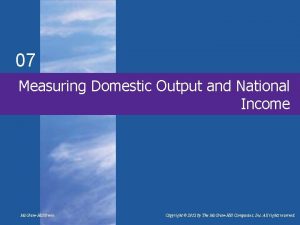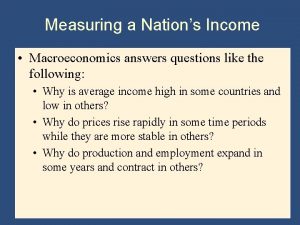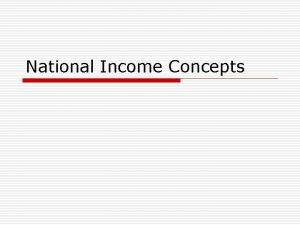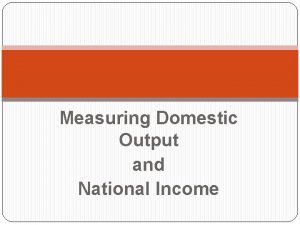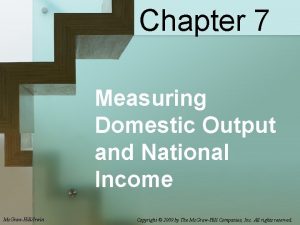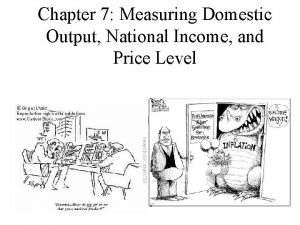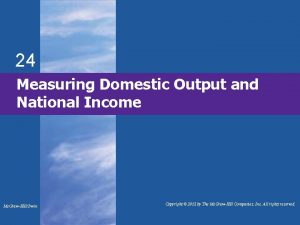Measuring Domestic Output and National Income Chapter 7





















- Slides: 21

Measuring Domestic Output and National Income Chapter 7

• Gross National Product (we stopped measuring GNP in 1992) – Total output produced by land, labor, capital and entrepreneurial talent supplied by Americans, whether these resources are located in the U. S. or abroad. • Gross Domestic Product (GDP) – Total output produced within the boundaries of the U. S. whether by American or foreign supplied resources

• GDP is a monetary measure: The reason for this is so that we can compare apples and oranges. – If we produce 1000 CDs, 1200 paper back books this year, and then next year produce 1000 paper back books and 1200 CDs, in which year was our GDP the highest? – You do not know unless you know that the price at which each sold for each given year.

Current GDP Figures • Accountants use the Value Added Approach to find this number – This is the market value of a firm’s output less the value of the inputs which has purchased from others. – The difference between what a firm pays for a product and what it receives from selling the product is paid out as wages, rent, interest, and profit. • We find the total value of the items by adding together all the values added by the firms – Similarly, by calculating and summing the values added to all the goods and services produced by all firms in the economy, we can find the market value of the economy’s total output – GDP.

• The Value Added approach will always be equal to the Final Product approach because profit is included in the value added approach. • All expenditures on goods and services will constitute an identical flow of income and profit for producers.

• GDP excludes non-production transactions such as – Financial Transactions: • Public transfer payments: Social Security, welfare, etc. • Private transfer payments: Gifts of money from relatives. • Security transactions: Buying and selling of stocks and bonds (this is just an exchange of paper assets). – Secondhand sales: • These goods have already been counted in a previous GDP

Problems With GDP • Does not measure underground economy • Does not measure goods bartered • Does not measure goods produced and sold at home unless this is reported. • Fails to take externalities into consideration • GDP Websites: – Map of world based on estimated wealth in 2015 – http: //www. worldmapper. org/display. php? selected=164 – http: //www. worldmapper. org/textindex/text_welath. html

Expenditure Approach • This adds up all that is spent to buy this year’s total output. • This takes into account C + I + G + Xn = GDP • C: Personal Consumption Expenditures – This includes all purchases by households on durables, non-durables and services (Consumption is the largest component of GDP) • I: Gross Private Domestic Investment – All spending by American firms. • All final purchases on machinery, equipment and tools • All construction: this includes all construction done even private home (because they could be rented), buildings and apartments. • Changes in inventory: You must look at additions to inventory at year end but NOT the subtractions (that inventor was counted last year).

Expenditure Approach (Cont. ) • G: Government Purchases – All governmental spending, Federal, state, and local, on finished products of businesses and all direct purchases of resources. It excludes transfer payments. • Xn: Net Exports: – The amount by which foreign spending on American goods and services exceeds American spending on foreign goods and services.

Approaches to Calculating GDP (Cont. ) • Expenditure Approach: GDP=C + I + G + Xn • Income Approach: Wages (compensation to employees) Rent Interest Profits (proprietors income) Consumption of fixed capital (Depreciation) Indirect Business Taxes Dividend +Undistributed Corporate Profits Gross National Produce - Net American Income Earned Aboard Gross Domestic Product

Approaches to Calculating GDP (Cont. ) Tear Down Approach: Gross Domestic Produce - Consumption of fixed capital Net Domestic Product + Net American income earned abroad - Indirect business taxes National Income (Income Earned) - Social Security Contributions - Corporate Income taxes - Undistributed corporate profits + Transfer payments Personal Income (Income Received ) -Personal Taxes Disposable Income

Income Approach: • Sums up all the incomes derived from the production of this years output. • GNP = wages + interest + profits + rents + indirect business taxes + depreciation. – Sometimes referred to as GDI (Gross Domestic Income).

• Wages: wages and salaries paid by business and government to suppliers of labor. – This includes taxes withheld and social security withheld. • Interest: Money paid to suppliers of money capital. – This comes from the business • Rent: Income payments received by households which supply property resources. – If depreciation exceeds rental income, it can be negative (a declining economy). • Our payments on houses are included because it is believed that we are renting from ourselves.

• Profits: Can be to the sole proprietor, the partnership or the corporation. – For corporation profits, it is important to understand what happens to this money. • Part of it goes to pay income taxes (corporate income taxes) • Part goes to the stockholders in the form of dividends • Part stays with the corporation for future use. This is called undistributed corporate profits, which increases the future assets of the business.

Consumption of Fixed Capital (Depreciation) • Businesses estimate the useful life of their capital goods and allocate the total cost of such goods more or less evenly over the life of the machine. • To accurately estimate profit, this depreciation must be deducted. • This is called Depreciation of Fixed Capital. • We consume the fixed capital as we use it (you may also see this referred to as Capital Consumption Allowance)

• We pay wages, rent, interest. . . And we must also pay for our machines. • This paper payment is depreciation – This is money that must be reinvested just to maintain the existing stock of capital. If corporations do not replace the capital, what is happening to the economy? (Declining) • Indirect Business Taxes: Taxes charged to the business are passed along to the buyer. – This means that it is included in GDP as profit. These taxes must be backed out.

• Now that we have all of this, we must subtract Net Income Earned Abroad to get GDP. • Net Income Earned Abroad: (Net output produced by Americans out of the U. S. ) – Subtract the total income payments to the rest of the world from total income receipts from the rest of the world. • NOTICE: This number can be negative if American-supplied resources produced and earned less abroad than foreign-owned resources produced and earned in the U. S.

Tear Down Approach This approach will allow you to see how much income people have for spending purposes • Gross Domestic Product: – Should show the well being of the economy. (Everything that was produced) • Problem: it includes depreciation. Is depreciation a real payment? NO • Therefore, depreciation must be deducted from GDP. • Will give more realistic picture of the production available for consumption and additions to capital stock.

• Net Domestic Product: – You must replace the machinery. It shows the annual output that the economy (households, businesses, government, and net exports) might consume without impairing our capacity to produce next year. • National Income: What it costs society to obtain its output (its GDP). – All income earned by American owned resources. – To get this you must look at • Income earned by Americans outside the U. S. (this must be added to GDP) • Indirect business taxes. You must subtract these taxes because this goes to the government and the government is not a resource of production. In other words, they get they tax money without adding to production.

• Personal Income (PI) – Income received. The income actually received by people • We pay the following so we must subtract them out: – Social Security contributions – Corporate Income Taxes – Undistributed Corporate Profits • You must add back transfer payment (unemployment compensation, welfare, disability …) This is income received but not currently earned (You have to add this back because it was not originally included in GDP)

• Disposable Income (DI) – Personal income less personal taxes. • (Personal Income – Personal Taxes = Disposable Income) – You can use your disposable income to either save or consume.
 Measuring domestic output and national income
Measuring domestic output and national income Outputs
Outputs Measuring domestic output and national income
Measuring domestic output and national income Measuring domestic output and national income
Measuring domestic output and national income Personal income formula in national income
Personal income formula in national income Gdp 519
Gdp 519 Measuring a nation's income
Measuring a nation's income Tax payable
Tax payable Operating income
Operating income Deferred tax asset journal entry
Deferred tax asset journal entry National income and product accounts
National income and product accounts Routine, universal screening for domestic violence means
Routine, universal screening for domestic violence means Ano ang pormula sa pagsukat ng pamamaraan ng gastusin
Ano ang pormula sa pagsukat ng pamamaraan ng gastusin Nnp calculation formula
Nnp calculation formula National income lesson plan
National income lesson plan National income formula
National income formula National income tax workbook
National income tax workbook Linear algebra
Linear algebra Final expenditure approach
Final expenditure approach What is national income
What is national income National income accounting equation
National income accounting equation Chapter 14:7 measuring and recording blood pressure
Chapter 14:7 measuring and recording blood pressure



